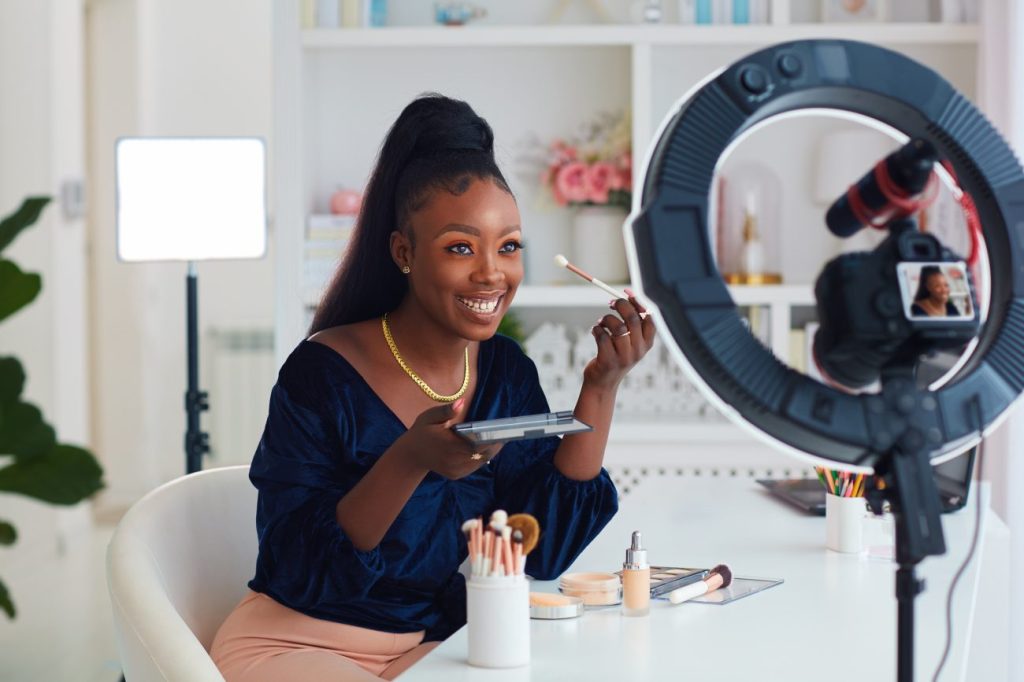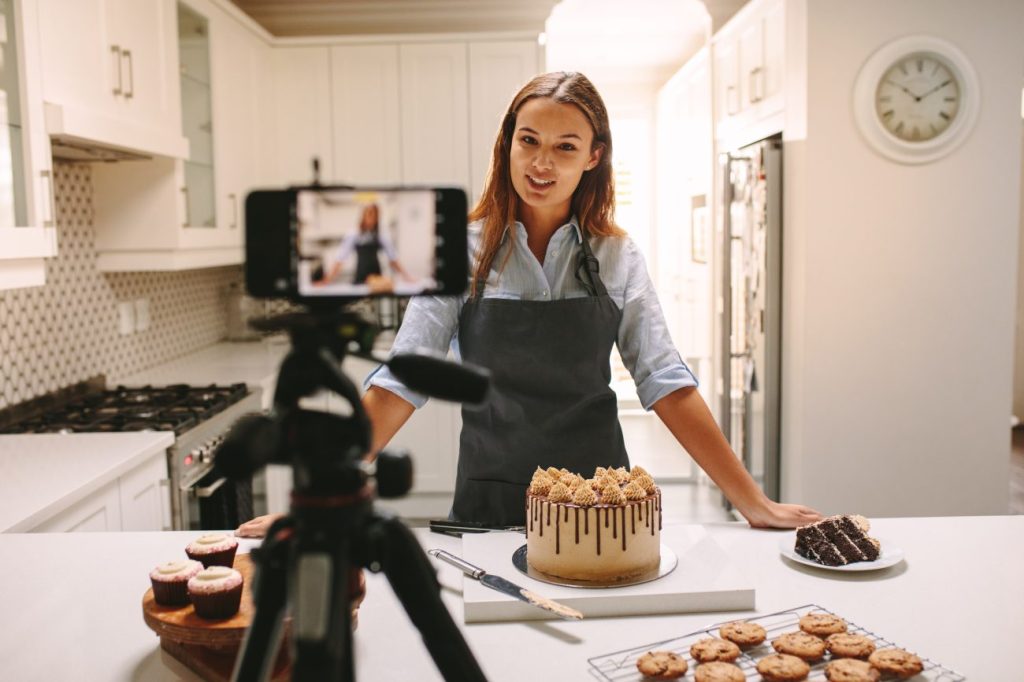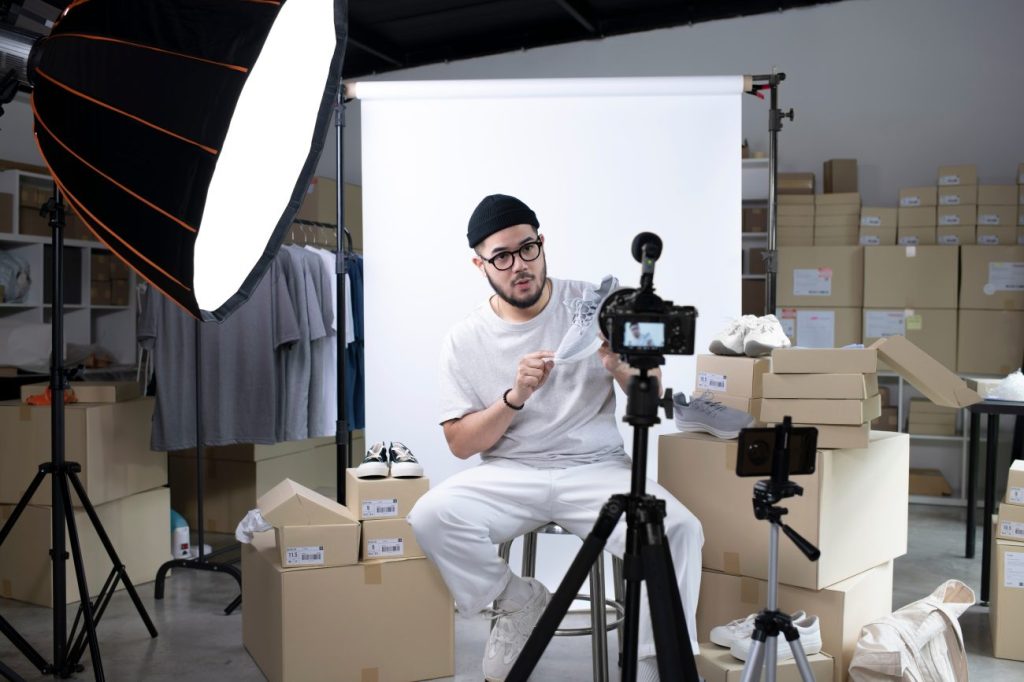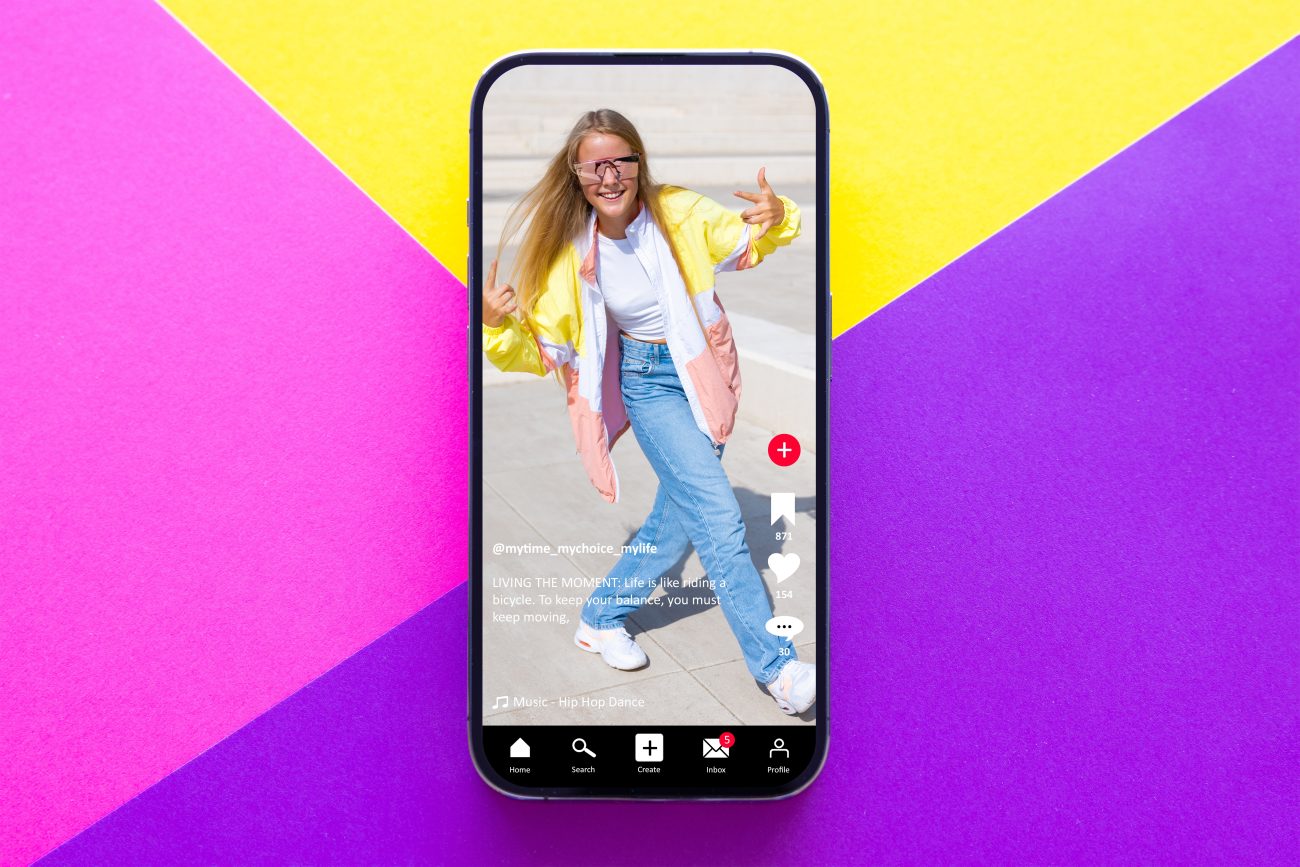If you’re on any social media platform at all, from TikTok to YouTube to Discord, you’ve probably run into an influencer or two (or 76). Influencers can be found on every social channel out there and they come from every demographic—from fashion “grandfluencers” like 96-year-old Helen Van Winkle (aka @baddiewinkle) to young beauty influencers like Avani Gregg who began posting on social media when she was 11 and now has brand partnerships (and was even invited to last year’s Met Gala).
Influencers have communities of followers who number from the tens of thousands all the way up into the many, many millions (see: 20-year-old Charli D’Amelio who has 151 million followers). Influencers might be into makeup, travel, gaming, or even gardening. But what they all have in common is a unique, personal viewpoint that helps them stand out as entertaining experts in their chosen field.
Want to follow in the footsteps of these successful social media stars? It doesn’t take a famous parent, an expensive tech setup, or a million online friends to get started. Here’s your step-by-step guide to becoming an influencer.

What is an influencer, anyway?
A professional social media influencer is someone who has a presence on a particular channel (often several) and uses their platform to share their interests or expertise. Their specialty, or niche, is directly or indirectly related to a category of products (think: video games, skincare, collectable toys, or sneakers).
Successful influencers are usually informative and entertaining at the same time, sharing images or videos that inspire their follower community to go out and buy the products or services they’re recommending.
Read more: How to become a professional gamer
Influencers vs. content creators
There’s a difference between influencers and content creators, though sometimes the roles can blur and overlap. For content creators, most of their earnings come directly from the platform they post on. The TikTok Creators Fund, for example, is paying content creators for the number of views or likes they receive from followers. They’ll sometimes branch out, selling ads or their own branded products via their social media accounts.
Read more: How kids and teens can make money on TikTok
Influencing works a little bit differently. Instead of trying to promote yourself as, for example, a makeup artist with your own makeup line, you’re promoting a brand’s makeup and skincare products (with the goal of getting the attention of brands who might want to send you free products or even pay you to showcase their makeup in your next tutorial or GRWM video).
What are the different types of influencers?
Starting out as a wannabe influencer might seem intimidating at first. How do you get Mr. Beast’s 48.6 million Instagram followers and a Samsung partnership by the time you turn 24?! First, take a deep breath. Even influencers with millions of followers and billions of likes all started at zero.
Here’s the thing: you don’t have to hit seven or eight digits in followers to have a successful influencer account. There are different categories of influencers and some brands will care less about the number of followers you have and more about how engaged your community is and how many members make a purchase after finding out about a brand or product through your social media post.
Here’s a general breakdown of the types of influencers and their following on social platforms:
Nano influencers
Nano influencers have around one to ten thousand followers and are usually really involved with their communities. Their audience is small enough that they can directly answer questions or respond to comments. While their follower numbers may be smaller, they have an outsized connection with their community which can sometimes translate into a large influence over follower’s buying habits and choices.
Micro influencers
Micro influencers are similar to nano influencers in that they, too, have smaller audiences but a greater connection with their followers. Influencers in the micro category have between ten and 50 thousand followers.
Macro influencers
Here’s where we start to get serious about numbers. Macro influencers have a big following—up to a million followers—and it’s those numbers that attract potential brand sponsors who want a lot of eyes on the product they’re trying to sell. Being a macro influencer is a fulltime job and can involve a lot of pressure to create high-quality, carefully crafted posts.
Mega influencers
Now we’re in celeb territory. Mega influencers (those with one million or more followers) are sometimes people who were already famous before launching a social account or they’re influencing geniuses who have expertly leveraged social media to attract massive followings. Think: Bella Poarch or Domelipa… or any of the other influencers we’ve name-dropped already.

7 steps to becoming an influencer
Okay, now for the info you’ve been waiting for. How to pull off this whole influencer thing for real, step by step:
1. Identify your speciality
The best thing about being an influencer is that you get to do a deep dive into a thing you already love. Ask yourself what you feel passionate about, what you think you might have a unique perspective on, and what topic you’re an expert in. Choose something that you feel like you could talk about every day to whoever will listen—whether that’s eco-conscious travel, playing and recording your own music, or special effects makeup.
It helps if you can also picture your audience. Who’s watching your videos? Who is clicking like on your posts? They’re probably people with the same interests as you, so you want to create content for them, while being sure to highlight your own unique perspective, experience, and ideas. Tell your story!
Check out the content that other young influencers are posting to get some inspiration for aesthetics, editing, and style. Aspiring fashion and/or dance influencers should check out Elliana Walmsley’s TikTok account where she posts try-on videos from shopping hauls, GRWM routines, and her interpretation of whatever dance routine is trending. Mari Copeny (aka Little Miss Flint) is a teen influencer and activist who creates content about water pollution and conservation. Evan Moana is a YouTuber known for his hilarious toy reviews and LEGO builds. And Lorenzo Greer is a 15-year-old British soccer player who already has an endorsement deal with Nike.
Remember: your channel will be unique because of your own creativity, so bring your own personality to the videos and photos you post. How? By using what’s special about you, while borrowing a little bit of inspiration from the pros.
2. Set up your social media profile
Time to pick your platform! Or platforms. Decide what kind of influencer content you want to make (videos or photos? reviews or how-tos?) and choose the social media channel that you think is the best fit. Most platforms have the same requirements. You’ll need a profile picture, a catchy username, and a short bio that tells your followers a little about you and the kinds of content you’ll be sharing.
3. Create relevant content
Relevant content is content that’s current and meaningful to you and to your audience. To help keep you on track and make sure that your content is something your followers look forward to, it’s a smart idea to create a content strategy.
Here’s what a content strategy might look like for a food influencer who’s decided to post four times a week (every week) under four different but repeating themes that all centre around food. It’s like a class schedule, but for social media:

- Monday post: Cook with Me (this could be a recipe video sharing your favourite quick and easy meal to start off the week)
- Wednesday post: Fridge Check (show followers the inside of your refrigerator highlighting one ingredient each week that you can’t do without)
- Friday post: Dinner with the Fam (here you’d post another cooking video sharing a more complex dish you like to eat with your family to kick off the weekend)
- Saturday post: My Favourite Spot (this could be a video featuring your ultimate dining out options, from take-out gems to special occasion sit down meals)
Successful social media influencers are consistent in what they post, knowing that their followers will come back to their content because they know what to expect and they look forward to more.
4. Build an online community
Consistency is also key when it comes to building your follower numbers. There is a LOT of content out there, and to keep your audience interested and engaged, you need to post regularly and on a predictable schedule.
Engagement is also important, especially when you’re just starting out. Go ahead and ignore any bots or trolls but try to interact with your genuine followers by answering questions about your content (not personal questions), and asking them questions in return. You can even ask questions in your original post. A beauty influencer may write, “This face mask really helped to clear up my skin, has anyone else tried it?” Talk to your audience. Tell them your story and give them the opportunity to share their own. Don’t be afraid to share what you really think, as long as your criticism is constructive. Your audience should stick with you for your authenticity and honesty.
Teaming up with other influencers can also help you grow your audience. Be sure to choose partners that make sense in terms of your brand and specialty. There are lots of ways to do this across different platforms, from shooting a YouTube video together to creating a collaborator post on Instagram to stitching a video on TikTok.
5. Create a media kit
Having a media kit ready and available to send to brands for partnership opportunities will make you look like a total pro and impress your potential clients. Your media kit should have:
- Your contact information including your name, your social media handle, your email address, and (if you have one) a link to your website
- A bio that lets brands know who you are, who your audience is, what kind of influencer content you make, and why you’re the right person to represent the brand on social media
- Your social stats—this can include the number of followers you have on different platforms and their engagement rate (to calculate this, divide the number of people who viewed a particular post by the number of engagements you got on that post, meaning likes, shares, and comments)
- Images or video stills taken from your account that best represent the kind of content you make and share
- If you’ve worked with brands in the past, you can include this information in your media kit, too
Be sure to make your kit visually appealing and representative of your brand (psst! you can find templates online). For inspiration, check out some examples of influencer media kits can be found here.
6. Collaborate with brands
Connecting with brands is probably the trickiest part of becoming a social media influencer. Sometimes it happens organically. A social media manager at a brand might notice that your content is getting a lot of likes or shares because you’ve featured and tagged that brand in your post. Some brands also use tracking software to monitor the reach of influencers. There are also tools like Tribe that you can use to get noticed by brands.
7. Keep learning!
Social media trends move quickly so in order to keep current and relevant, you need to keep learning. Did your social media platform just launch a new feature? Read up on how to use it and start to experiment. Have you earned enough money to invest back into your influencer career? Do some research on the latest lights, cameras, and editing software that other influencers are using to create their content.
Above all, spend time on the platform you use most. Know your TikTok memes and keep on top of the catchiest viral tracks that other influencers are using as background music.

How much can influencers make?
The amount of money an influencer can make falls within a pretty large range. Average influencer earnings range from $195 USD for one Instagram post by a nano influencer to $1,804 USD per Instagram post for a macro influencer. Your earnings will depend on a few factors, like:
- Which platform you post on
- How many followers you have
- Your engagement rate
- Your specialty or niche
- What kind of content you sharing on behalf of a brand (eg. a post versus a story)
If you want to become a social media influencer, the good news is that the key tool is probably already in your hands (literally—it’s that smartphone you’re holding). Add your creativity, passion, and personality, and you’ve got all the ingredients for success (and some extra cash).
Download Mydoh and help build the foundation of financial literacy for your kids and teenagers.
This article offers general information only and is not intended as legal, financial or other professional advice. A professional advisor should be consulted regarding your specific situation. While the information presented is believed to be factual and current, its accuracy is not guaranteed and it should not be regarded as a complete analysis of the subjects discussed. All expressions of opinion reflect the judgment of the author(s) as of the date of publication and are subject to change. No endorsement of any third parties or their advice, opinions, information, products or services is expressly given or implied by Royal Bank of Canada or its affiliates.








